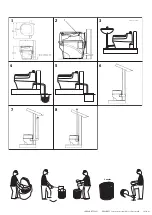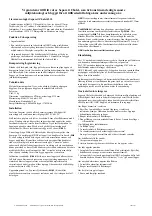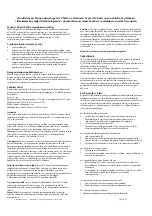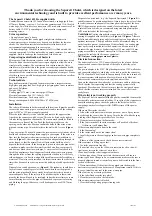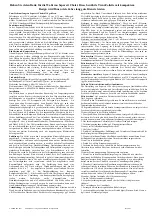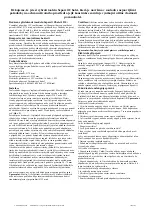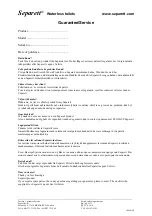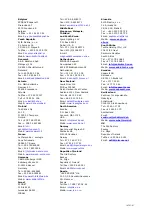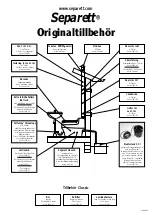
© SEPARETT 2003 SEPARETT is a registered trademark for Separett AB
10341-01
Thank you for choosing the Separett Chalet, which is designed on the latest
environmental technology and is built to provide excellent performance over many years.
The Separett Chalet 4210 is supplied with:
Ventilation connector with 12V fan and insect mesh, venting pipe (40 cm,
Ø75 mm), flashing, vent, cowl, 2 solid waste containers and 1 lid, 10 solid
waste bags, 2 m white hose for urine waste (Ø32 mm) with connectors, 2 m
battery cable, 12/230V power adapter, silicone sealant compound,
mounting screws.
Urine separation
• No unpleasant ‘privy’ odours.
• Clean (sterile) urine that can be piped straight into the domestic
wastewater system, to a soakaway or be used as a fertiliser for lawns or
shrubs. You should contact the local authorities to find out which
environmental regulations apply in your region.
• Unlimited capacity: When the container is full, it is lifted out and the
contents composted. It is then replaced by an empty container. 2 containers
supplied. Built-in fan keeps the room dry and free of odours.
Composting/neutralisation of bacteria
Mix some soil into the container and cover the contents with a layer of soil.
Place the lid on the container but leave it open slightly to allow the air to
circulate in the compost. The container and its contents must be left to
stand for six (6) months (this is the period currently required under health
and safety regulations in Sweden). Once the composting period has ended,
the contents of the container can be dug into the garden or compost. Traces
of toilet paper, etc. quickly decompose and the compost makes an excellent
garden soil improver.
Technical data
Recyclable materials: Upper and lower main sections: impact-resistant,
high-gloss polypropylene. Seat: high-gloss polypropylene. Inner container
and cover: Polythene.
Weight: 11 kg
Venting pipe: Ø75 mm. Urine waste pipe: Ø32 mm.
Electrical equipment: Fan 12V: 160mA, 1.9W
Electrical connection: 2 m battery cable.
Energy consumption: 0.0456 kWh/24 hrs (17 kWh/year).
Installation
The toilet will function in both warm and cold locations. It must be possible
to route the urine waste pipe to a suitable outlet and to install the venting
pipe. A 230V or 12V power supply is needed.
Place the toilet where it is to be installed and remove the upper section.
Attach the fan connector with 4 screws. This can be fitted on the right or
left side facing upwards or backwards. The insect mesh should be fitted in
the connector in front of the fan. Push the flashing into place on the
opening on the other side. Mark out and make holes for the urine waste
pipe and venting pipe. Attach the toilet to the wall with 3 screws (
Figure
2
).
Urine waste pipe: You should contact the local authorities to find out which
health and environmental regulations apply in your region. If the urine is to
flow into the domestic wastewater system (e.g. beneath a washbasin or
shower) (
Figure 3
), the waste pipe must have an adequate drop through its
entire length, so that the normal flow will prevent the build-up of salt
deposits inside this drain. If the hose/pipe is joined to the waste pipe below
a washbasin, make sure that the water from the basin flows out properly
and does not block the urine waste pipe. A water seal will only need to be
fitted if an unpleasant odour is apparent from the domestic waste pipe up
through the toilet or from the venting pipe outside the house. As this very
seldom happens, it is best to wait until the problem occurs before adding a
water seal. If a water seal is installed, it is important to rinse the toilet every
time it has been used in order to prevent the build-up of salt deposits in the
seal.
Disposal via a sand bed soakaway:
(
Figure 4
) The soakaway should have a
layer of stone or suitable gravel at the bottom where the urine pipe ends,
and the urine pipe should have a steady drop from the toilet to its end to
ensure adequate flow. If the toilet is to be used during the colder winter
months, the hose will need to be insulated. In harsh winter climates, some
form of heating device for the pipe will be needed to prevent ice forming
and blocking the pipe. Otherwise, it will be adequate to use Ø50-75 mm
piping.
Disposal via a urine tank: (e.g. the ‘Separett Ejectortank’) (
Figure 5
) A
suitable tank can be positioned outdoors. It must be at a lower level than
the toilet to ensure an adequate flow throughout the length of the hose.
NB!
If the urine pipe needs to be routed close to radiators or through
insulated floors or walls, we recommend using standard plastic pipes
(Ø32 mm) instead of the hose supplied.
Ventilation:
Venting through either an outer wall or the roof. The
venting kit supplied with the toilet is for
Figure 6
. If
Figures 7-8
are to
be followed, additional piping and sleeve couplings can be purchased as
optional accessories. The pipe will then need to be insulated along its
entire length to prevent condensation. If there already is a venting pipe
from a previously installed toilet, the Separett can be connected to it,
whatever the pipe diameter. Sealant rings for Ø55 mm and Ø110 mm
piping are available as optional accessories. All joints in the venting
pipe must be sealed with silicone or equivalent.
NB! Only use venting pipes made of plastic.
Electrical connection:
The battery cable is for 12V. Connect the cable to the plug on the fan
connector and connect the other end of the cable to a battery, solar
panel, etc.
The power adapter is for 230V. Plug the adapter into a 230V wall socket
and connect the adapter’s cable plug to the socket on the fan connector.
NB! The fan should be allowed to run constantly. If the fan is turned off,
the inner container with paper and faeces will need to be lifted out.
Otherwise the container may start to smell and attract flies
Connect the adapter to the wall socket or the battery cable to the battery.
Check that the fan is operating and that the venting system is fully
functional. Press down on the seat to ensure that the view guard opens.
Check that the container rotates as intended. Your new toilet is now
ready for use.
If the toilet is not working properly
The Separett Chalet is manufactured and quality-controlled to ensure the
best possible performance and reliability. If, in spite of this, it appears to
be malfunctioning, please check the points in the list below before
contacting your dealer or Separett AB.
NB!
First turn off the power
supply!
If there are flies inside the toilet
1 Lift out the solid waste container and put a new one in. Spray inside
the toilet and the room with a fly spray. Turn the fan off while the spray
is taking effect. Repeat this procedure for a few days.
2 Clean the insect mesh on the fan intake.
3
If the fan is turned off, the urine container will need to be lifted out.
Otherwise it will attract flies.
If there is an unpleasant odour in the room
1 Is the fan running?
2 Is the insect mesh on the fan intake clean?
3 Are all the joints in the venting pipe and urine waste pipe completely
tight?
If there is a floor drain, check that it has a correct water seal.
If the container is filling up too fast
1 Use toilet paper more frugally.
2
If urine finds its way into the solid waste container too often, this will
significantly increase the volume of waste there.
If an odour from the toilet is apparent outdoors
1 Latrine-type odour. If urine gets into the container it will cause a
latrine-type odour. Change to a new container and make sure the seat is
properly adjusted to make it easier for urine to be directed into the front
section of the toilet.
2 Waste water odour. If the urine is being piped into the domestic
wastewater system, this can be the source of unpleasant smells. If this is
the case, install a water seal in the urine waste pipe.
If the fan is noisy or causing vibration
1 Is the toilet fixed securely into place?
2 Clean the insect mesh on the fan intake.
If the wastewater system is blocked
1 Clear the blockage using proper cleaning rods.


